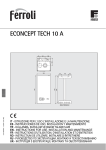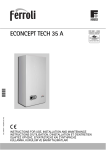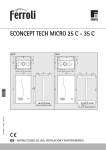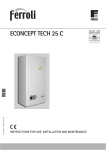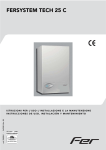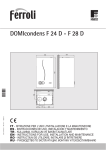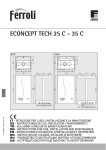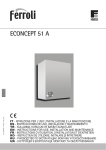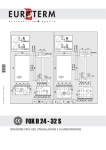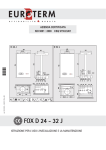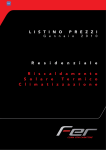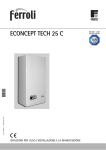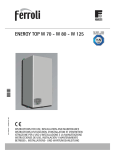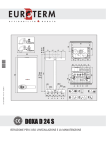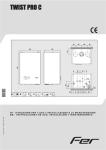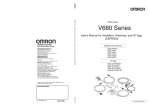Download DOMIcondens HE 26c - Manual
Transcript
DOMIcondens HE 26 C 330 196 = 700 400 115 200 cod. 3540Z852 — Rev. 01 - 08/2012 85 INSTRUCTIONS FOR USE, INSTALLATION AND MAINTENANCE IMPORTANT • Your "benchmark" Installation, Commissioning and Service Record Log Book is enclosed in the last pages of this manual. “This record must be completed and left with the end user”. Ferroli is a member of the Benchmark initiative and fully supports the aims of the programme. Benchmark has been introduced to improve the standards of installation and commissioning of central heating systems in the UK and to encourage the regular servicing of all central heating systems to ensure safety and efficiency. Please see installation and servicing guidelines. • "Ferroli declare that no substances harmful to health are contained in the appliance or used during the appliance manufacture”. B This symbol indicates "Caution" and is placed next to all safety warnings. Strictly follow these instructions in order to avoid danger and damage to persons, animals and things. A This symbols calls attention to a note or important notice. 2009/142 200 200 2 EN EN cod. 3540Z852 - Rev. 01 - 08/2012 DOMIcondens HE 26 C EN Comfort 1. GENERAL WARNINGS Fault • • In case of a fault (see cap. 4.4) the display shows the fault code (detail 11 - fig. 1) and, during safety standby times, the messages "d3" and "d4". • • • • • • • • • A Comfort demand (reinstatement of temperature inside the boiler) is indicated by flashing of the water under the tap on the display. The display (detail 11 - fig. 1) shows the actual temperature of the water in the boiler. Carefully read and follow the instructions contained in this instruction booklet. After boiler installation, inform the user regarding its operation and give him this manual, which is an integral and essential part of the product and must be kept with care for future reference. Installation and maintenance must be carried out by professionally qualified personnel, in compliance with the current regulations and according to the manufacturer's instructions. Do not carry out any operation on the sealed control parts. Incorrect installation or inadequate maintenance can result in damage or injury. The Manufacturer declines any liability for damage due to errors in installation and use, or failure to follow the instructions. Before carrying out any cleaning or maintenance operation, disconnect the unit from the electrical power supply using the switch and/or the special cut-off devices. In case of a fault and/or poor operation, deactivate the unit and do not try to repair it or directly intervene. Contact professionally qualified personnel. Any repair/replacement of the products must only be carried out by qualified personnel using original replacement parts. Failure to comply with the above could affect the safety of the unit. This unit must only be used for its intended purpose. Any other use is deemed improper and therefore hazardous. The packing materials are potentially hazardous and must not be left within the reach of children. The unit must not be used by people (including children) with limited physical, sensory or mental abilities or without experience and knowledge of it, unless instructed or supervised in its use by someone responsible for their safety. The unit and its accessories must be appropriately disposed of, in compliance with the current regulations. The images given in this manual are a simplified representation of the product. In this representation there may be slight and insignificant differences with respect to the product supplied. 2. OPERATING INSTRUCTIONS 2.3 Lighting and turning off Connection to the power supply • • • During the first 5 seconds the display will also show the card software release. Open the gas cock ahead of the boiler. The boiler is now ready to function automatically whenever domestic hot water is drawn or in case of a heating demand (generated by Room Thermostat or Remote Temperature Control). Turning the boiler off and on Press the on/off button (detail 7 - fig. 1) for 5 seconds. fig. 2 - Turning the boiler off When the boiler is turned off, the PCB is still powered. Domestic hot water and heating are disabled. The antifreeze system remains activated. To relight the boiler, press the on/off button (detail 7 - fig. 1) again for 5 seconds. 2.1 Introduction Dear Customer, DOMIcondens HE 26 C is a high-efficiency sealed chamber condensing heat generator for heating and hot water production running on natural gas or LPG, and equipped with a microprocessor control system. 2.2 Control panel Panel 1 2 9 10 15 7 17 fig. 3 The boiler will be immediately ready to work whenever domestic hot water is drawn or in case of a heating demand (generated by the Room Thermostat or the Remote Timer control). B 8 5 11 eco comfort reset 12 The antifreeze system does not work when the power and/or gas to the unit are turned off. To avoid damage caused by freezing during long idle periods in winter, it is advisable to drain all water from the boiler, DHW circuit and system; or drain just the DHW circuit and add a suitable antifreeze to the heating system, complying with that prescribed in sec. 3.3. 2.4 Adjustments Summer/Winter Switchover Press the summer/winter button (detail 6 - fig. 1) for 2 seconds. The display activates the Summer symbol (detail 10 - fig. 1): the boiler will only deliver domestic hot water. The antifreeze system remains activated. 16 6 Heating temperature adjustment fig. 1 - Control panel Use the heating buttons (details 3 and 4 - fig. 1) to vary the temperature from a min. of 30°C to a max. of 80°C; in any case, it is advisable not to operate the boiler below 45°C. III III fig. 4 DHW temperature adjustment Use the DHW buttons (details 1 and 2 - fig. 1) to adjust the temperature from a min. of 40°C to a max. of 50°C. III III Panel key fig. 1 1 DHW temperature setting decrease button 2 DHW temperature setting increase button 3 Heating system temperature setting decrease button 4 Heating system temperature setting increase button 5 Display 6 "Sliding Temperature" Menu - Summer/Winter mode selection - Reset button 7 Unit On/Off - Economy/Comfort mode selection button 8 DHW symbol 9 DHW mode 10 Summer mode 11 Multifunction 12 Eco (Economy) mode 13 Heating 14 Heating symbol 15 Burner lit and actual power level (flashing during combustion fault function) 16 Service Tool connection 17 Arrangement for clock III 4 13 III 14 3 To deactivate the Summer mode, press the summer/winter button (detail 6 - fig. 1) again for 2 seconds. Indication during operation Heating A heating demand (generated by the Room Thermostat or Remote Timer Control) is indicated by flashing of the hot air above the radiator on the display. The display (detail 11 - fig. 1) shows the actual heating delivery temperature and, during heating standby time, the message “d2”. Domestic hot water (DHW) A DHW demand (generated by drawing domestic hot water) is indicated by flashing of the hot water under the tap on the display. The display (detail 11 - fig. 1) shows the actual DHW outlet temperature and, during DHW standby time, the message “d1“. fig. 5 Room temperature adjustment (with optional room thermostat) Using the room thermostat, set the temperature required in the rooms. If the room thermostat is not installed, the boiler will keep the system at the set system delivery setpoint temperature. Room temperature adjustment (with optional remote timer control) Using the remote timer control, set the required temperature in the rooms. The boiler will adjust the system water according to the required room temperature. For operation with remote timer control, please refer to the relevant instruction manual. cod. 3540Z852 - Rev. 01 - 08/2012 EN 3 DOMIcondens HE 26 C ECO/COMFORT selection 3. INSTALLATION The unit has a function that ensures a high domestic hot water delivery speed and maximum comfort for the user. When the device is activated (COMFORT mode), the water contained in the boiler is kept hot, thereby ensuring immediate availability of hot water on opening the tap, without waiting times. 3.1 General Instructions The user can deactivate the device (ECO mode) by pressing the eco/comfort button (detail 7 - fig. 1). In ECO mode the display activates the ECO symbol (detail 12 - fig. 1). To activate the COMFORT mode, press the eco/comfort button (detail 7 - fig. 1) again. Sliding Temperature When the optional external probe is installed, the boiler adjustment system works with "Sliding Temperature”. In this mode, the temperature of the heating system is controlled according to the outside weather conditions, to ensure high comfort and energy saving throughout the year. In particular, the system delivery temperature is decreased as the outside temperature increases, according to a specific "compensation curve”. B This unit must only be used for its intended purpose. This unit is designed to heat water to a temperature below boiling point and must be connected to a heating system and/or a water supply system for domestic use, compatible with its performance, characteristics and its heating capacity. Any other use is deemed improper. BOILER INSTALLATION MUST ONLY BE CARRIED OUT BY QUALIFIED PERSONNEL, IN ACCORDANCE WITH ALL THE INSTRUCTIONS GIVEN IN THIS TECHNICAL MANUAL, THE PROVISIONS OF CURRENT LAW, THE PRESCRIPTIONS OF THE TECHNICAL STANDARDS (BS), ANY LOCAL REGULATIONS AND THE RULES OF PROPER WORKMANSHIP. Incorrect installation can cause damage or injury for which the manufacturer declines any responsibility. With Sliding Temperature adjustment, the temperature set with the heating buttons (detail 3 - fig. 1) becomes the maximum system delivery temperature. It is advisable to set a maximum value to allow system adjustment throughout its useful operating range. Installation of this unit must be carried out in strict compliance with the present instructions and the following regulations applicable in Great Britain. The boiler must be adjusted at the time of installation by qualified personnel. Possible adjustments can in any case be made by the user to improve comfort. Local Building Regulations.. Compensation curve and curve offset Press the reset button (detail 6 - fig. 1) for 5 seconds to access the "Sliding temperature" menu; the display shows "CU" flashing. Use the DHW buttons (detail 1 - fig. 1) to adjust the curve from 1 to 10 according to the characteristic. By setting the curve to 0, sliding temperature adjustment is disabled. Gas Safety Regulations (Installations & Use). The Building Regulations (Part L). The Buildings Standards (Scotland - Consolidated) Regulations. British Standards Codes of Practice (BSI): B.S. 5440 Detail 1 B.S. 5440 Detail 2 Air supply and ventilation B.S. 5449 ......... Systems for hot water production with forced circulation Press the reset button (detail 6 - fig. 1) again for 5 seconds to exit the "Sliding Temperature" menu. B.S. 6798 ......... Installation of gas-fired boilers for hot water B.S. 6891 ......... Gas systems If the room temperature is lower than the required value, it is advisable to set a higher order curve and vice versa. Proceed by increasing or decreasing in steps of one and check the result in the room. B.S. 7671 ......... IEE wiring system regulations B.S. 4814 ......... Specifications for expansion tanks B.S. 5482 ......... LPG systems B.S. 7593 ......... Water treatment in central heating systems for domestic hot water production B.S. 5546 ......... Installation of systems for domestic hot water production Press the heating buttons (detail 3 - fig. 1) to access parallel curve offset; the display shows "OF" flashing. Use the DHW buttons (detail 1 - fig. 1) to adjust the parallel curve offset according to the characteristic (fig. 6). OFFSET = 20 OFFSET = 40 90 85 80 10 9 8 6 5 70 4 60 3 50 2 40 1 30 20 7 20 10 0 -10 -20 90 85 80 10 9 8 7 6 5 4 3 70 2 60 Model Water By-Laws 1 50 40 B.S. 30 20 20 10 0 -10 5955-8 ......... Installation of plastic pipes -20 fig. 6 - Example of compensation parallel curve offset Adjustments from Remote Timer Control A Flues If the Remote Timer Control (optional) is connected to the boiler, the above adjustments are managed according to that given in table 1. For Northern Ireland, observe the current applicable regulations. Safe handling of materials Pay attention when handling the boiler insulation panels because the material they are made of could irritate the skin. No part of the boiler contains asbestos, mercury or CFC's. Advice for transport and handling Table. 1 Heating temperature setting Adjustment can be made from the Remote Timer Control menu and the boiler control panel. For lifting and transport always take suitable safety precautions: keep your back straight, bend knees, do not turn your body, move feet, avoid bending forward or sideways and keep the load as close as possible to your body. Hot water temperature adjustment Adjustment can be made from the Remote Timer Control menu and the boiler control panel. If possible, use a trolley or other suitable means to carry the boiler. Summer/Winter Switchover Summer mode has priority over a possible Remote Timer Control heating demand. Eco/Comfort selection Adjustment can only be made from the boiler control panel. Water system pressure regulation The filling pressure read on the boiler water gauge with the system cold must be approx 1.0 bar. If the system pressure falls to values below minimum, the boiler stops and fault F37 is displayed. Grip the boiler firmly and, before lifting it, try and find the point where the load is concentrated in order to establish the centre of gravity and suitably reposition yourself. 3.2 Place of installation The combustion circuit is sealed with respect to the place of installation, therefore the unit can be installed in any room. However, the place of installation must be sufficiently ventilated to prevent the creation of dangerous conditions in case of even small gas leaks. This safety standard is required by the EEC Directive no. 2009/142 for all gas units, including those with sealed chamber The unit is suitable for operation in a partially protected place in compliance with EN 297 pr A6, for temperatures to -5°C. It is advisable to install the boiler under the slope of a roof, inside a balcony or in a sheltered recess. Therefore the place of installation must be free of dust, flammable materials or objects or corrosive gases. The boiler is arranged for wall mounting and comes standard with a hooking bracket. Fix the bracket to the wall according to the measurements given in the cover drawing and hook the boiler on it. A metal template for marking the drilling points on the wall is available by request. The wall fixing must ensure stable and effective support for the generator. the unit is enclosed in a cabinet or mounted alongside, a space must be proA Ifvided for removing the casing and for normal maintenance operations 4 EN cod. 3540Z852 - Rev. 01 - 08/2012 DOMIcondens HE 26 C 3.3 Plumbing connections Shutoff valve kit Important Make sure to install the shutoff valves (supplied) between the boiler and the heating system, allowing the boiler to be isolated from the system if necessary. The heating capacity of the unit must be previously established by calculating the building's heat requirement according to the current regulations. To ensure proper operation and long boiler life, the plumbing system must be adequately sized and complete with all the necessary accessories, including a room thermostat, a thermostattable valve (TRV) etc. The system delivery and return pipes must have a diameter of at least 22 mm for the first 3 m of length from the unit. If the system delivery and return pipes follow a path where air pockets can form in certain places, it is advisable to install vent valves at these points. Also, type "A" drain cocks must be installed at the lowest points in the system to allow complete emptying. B An automatic bypass with flow rate of at least 6 l/min. must be installed (connected as far away as possible from the boiler) if radiators with thermostatic valves have been connected. B The safety valve outlet must be connected to a copper pipe of 15 mm diameter with continuous fall from the boiler to run off the system water in case of overpressure in the heating circuit. Otherwise, if the discharge valve cuts in and floods the room, the boiler manufacturer cannot be held liable. The drain must be run to the outside of the building to avoid the risk of damage or injury due to the hot water in case of overpressure in the system. Make the boiler connection in such a way that its internal pipes are free of stress. If a non-return valve is installed also on the DHW circuit (if provided for), it is necessary to install a safety valve between the boiler and the circuit (with the non-return valve at least 3 m from the boiler) or an expansion tank for domestic use. For installation, follow the instructions contained in the kit. Replenishing water It is necessary to provide for replenishing of the water lost by the sealed system. Refer to standard BS6798 for the methods of filling and replenishing water in sealed systems. There must not be a direct connection between the central heating system of the boiler and the water mains. For the use of water coming from the water mains and direct pressurisation of the system, refer to the local water management by-laws. This connection must be interrupted after use. Hot water The boiler comes standard with the connection (filling loop) shown in fig. 9. For installation, follow the instructions given on the instruction sheet enclosed with the kit Gas To replenish the water in the system: • • Cold water mains Additional expansion vessel C.H. (if required) • • Fix the removable connection “1” between the two valves. Open the two cocks “2 and 3” until the pressure read on the water gauge is approx. 1 bar. Close the two cocks “2 and 3”. At the end of the operation, remove the removable connection “1”. Reference is made to the provisions contained in the water management by-laws. Filling point C.H. Automatic Bypass fig. 7 - Automatic bypass connection fig. 9 - Filling loop The temperature drop between the delivery manifold and the return to the boiler should not exceed 20°C. B Do not use the water system pipes to earth electrical appliances. Before installation, carefully wash all the pipes of the heating system to remove any residuals or impurities that could affect proper operation of the unit (as required by BS 7593 Building regs Doc L). Carry out the connections to the unit as indicated in fig. 8. 6 Water treatment If water treatment is necessary, Ferroli recommends the exclusive use of specific products such as Fernox or Sentinel to be applied according to the producer's instructions. For further information, please contact: Fernox Manufacturing Co. LTD. Cookson Electronics, Forsyth Road Sheerwater, Woking, Surrey, GU21 5RZ Tel.: 0870 8700362 Sentinel Performance Solutions Ltd The Heath Business & Technical Park Runcorn, Cheshire WA7 4QX Tel.: 0151 424 5351 If the boiler is installed in an existing system, any unsuitable additives must be A removed by thoroughly cleaning the system. Cleaning of all the systems must 3 4 be done in compliance with the requirements of standard B.S. 7593. 5 with hard water, treatment may be necessary in order to prevent scale A Infromareas forming in the boiler. sure to use the water treatment product in the right concentration, accordA Make ing to the producer's instructions. 36 60 60 89 95 204 2 158 1 3.4 Gas connection The gas must be connected to the relevant union (see figure on cover) in conformity with the current regulations, with a rigid metal pipe or with a continuous surface flexible s/steel tube, installing a gas cock between the system and boiler. Make sure all the gas connections are tight. 60 fig. 8 - Plumbing connections cod. 3540Z852 - Rev. 01 - 08/2012 EN 5 DOMIcondens HE 26 C 3.5 Electrical connections Connection with coaxial pipes Important Standard coaxial installation Between 10 e 60 mm Front view Ø100 125 80 Ø100 125 041025G0 196 200 Drill the wall 10÷20 mm more than the pipe diameter 200 700 B The unit's power cable must not be replaced by the user; if damaged, switch the unit off and have the cable replaced by professionally qualified personnel. If replacing the power cable, only use "HAR H05 VV-F" 3x0.75 mm2 cable with max. ext. diameter of 8 mm. Side outlet Between 10 e 60 mm Side view 80 The boiler is prewired and provided with a "Y" type cable (without plug) for connection to the electric line. The connections to the power supply must be permanent and equipped with a double-pole switch with contact opening distance of at least 3 mm, installing fuses of max. 3A between the boiler and the line. Make sure to respect the polarities (LINE: brown wire / NEUTRAL: blue wire / EARTH: yellow/green wire) in connections to the electric line. Rear outlet 700 B The unit must be connected to an efficient earthing system in conformity with current safety regulations. Have the efficiency and suitability of the earthing system checked by professionally qualified personnel; the Manufacturer declines any liability for damage caused by failure to earth the system. Room thermostat (optional) IMPORTANT: THE ROOM THERMOSTAT MUST HAVE VOLTAGE-FREE CONTACTS. CONNECTING 230 V TO THE ROOM THERMOSTAT TERMINALS WILL PERMANENTLY DAMAGE THE ELECTRONIC BOARD. When connecting time controls or a timer, do not take the power supply for these devices from their breaking contacts Their power supply must be by means of direct connection from the mains or with batteries, depending on the kind of device. 330 400 Accessing the electrical terminal block fig. 12 - Standard coaxial installation Follow the instructions given in fig. 10 to access the electrical connections terminal block. The layout of the terminals for the various connections is also given in the wiring diagram in fig. 26. 138 Other coaxial connections 72 C1X 3 4 3 5 4 5 6 C3X C3X C3X fig. 13 - Examples of connection with coaxial pipes ( C1X C1X = Air / = Fumes) Table. 2 - Typology 6 Type C1X C3X 139 Description Wall horizontal exhaust and inlet Roof vertical exhaust and inlet For coaxial connection, fit the unit with one of the following starting accessories. For the wall hole dimensions, refer to the figure on the cover. Any horizontal sections of the fume exhaust must be kept sloping slightly towards the outside, to prevent condensate from flowing back towards the unit. fig. 10 - Accessing the terminal block 3.6 Fume ducts Important Ø 102 Ø 127 Ø 61.5 Ø 80.5 120 The unit is “type C” with sealed chamber and forced draught; the air inlet and fume outlet must be connected to one of the following extraction/suction systems. Before installation, check and carefully observe the above prescriptions. Also, comply with the provisions concerning the positioning of wall and/or roof terminals and the minimum distances from windows, walls, vents, etc. 120 B Expansion fume exhaust pipes longer than 1 metre, during installation take in account A For the natural expansion of the materials when the boiler is operating. 041006X0 Ø 61.6 Boiler operation requires fitting the baffles supplied with the unit, according to that given in the following tables. 68.5 Before inserting the fume exhaust pipe, check the presence of the right baffle (when it is to be used) and that it is correctly positioned. The boilers are fitted standard with the smallest diameter baffle. To replace the baffle (ref. 1 - fig. 11), proceed as indicated in fig. 11. 90.5 041002X0 Baffles Ø 100.5 To prevent any deformation, leave an expansion space of approx. 2 ÷ 4 mm for every metre of pipe. 1 041001X0 fig. 14 - Starting accessory for coaxial ducts Table. 3 - Baffles for coaxial ducts Max. permissible length Reduction factor 90° bend Reduction factor 45° bend fig. 11 6 EN Baffle to use cod. 3540Z852 - Rev. 01 - 08/2012 Coaxial 60/100 6m 1m 0.5 m 0÷2m Ø 45 2÷4m Ø 50 4÷6m no baffle Coaxial 80/125 12 m 0.5 m 0.25 m 0÷6m Ø 45 6 ÷ 12 m no baffle DOMIcondens HE 26 C Connection with separate pipes Position of terminals Q l Q Q P F D, E C1x fig. 15 - Examples of connection with separate pipes ( = Air / B N C G M L N H A H M B2x C3x max 50 cm C5x J K = Fumes) Table. 4 - Typology Type C1X Description Wall horizontal exhaust and intake. The inlet/outlet terminals must be concentric or close enough to be undergo similar wind conditions (within 50 cm) Roof vertical exhaust and intake. Inlet/outlet terminals like for C12 Wall or roof exhaust and intake separate or in any case in areas with different pressures. The exhaust and intake must not be positioned on opposite walls. Intake and exhaust with separately certified pipes (EN 1856/1) Intake from installation room and wall or roof exhaust C3X C5X C6X B2X fig. 17 Minimum dimensions of fume exhaust terminals IMPORTANT - THE ROOM MUST BE PROVIDED WITH APPROPRIATE VENTILATION For connection of the separate ducts, fit the unit with the following starting accessory: Ø 87 Ø 65 Ø 81 Ø 65 Ø 81 041039X0 fig. 16 - Starting accessory for separate ducts Before installation, check the baffle to be used and make sure the maximum permissible length has not been exceeded, by means of a simple calculation: 1. 2. 3. Completely establish the layout of the system of split flues, including accessories and outlet terminals. Consult the table 6 and identify the losses in meq (equivalent metres) of every component, according to the installation position. Check that the sum total of losses is less than or equal to the maximum permissible length in table 5. A Directly under an opening, air inlet, openable window, etc. 300 mm B Above an opening, air inlet, openable window, etc. 300 mm C Horizontally to an opening, air inlet, openable window, etc. 300 mm D Under gutters, drain pipes 75 mm E Under cornices or under eaves 200 mm F Under balconies or garages 200 mm G From a drain pipe or a vertical drain pipe 150 mm H From an internal or external corner 100 mm 300 mm I Above ground level, a roof or balcony J From a surface facing the terminal 600 mm K From a terminal facing the terminal 1200 mm litres From a garage opening (e.g. door, window) with access to the home 1200 mm M Vertically from a terminal on the same wall 1500 mm No Horizontally from a terminal on the same wall 300 mm O From the wall on which the terminal is fitted P From a vertical structure on the roof 150 mm Q Above the intersection with the roof 300 mm • • Table. 5 - Baffles for separate ducts Separate ducts 55 meq Max. permissible length Baffle to use 0 ÷ 15 meq Ø 45 15 ÷ 35 meq Ø 50 35 ÷ 55 meq No baffle • NOTES • Table. 6 - Accessories Losses in meq Ø 80 Ø 60 PIPE 1 m M/F BEND 45° M/F 90° M/F PIPE SECTION with test point TERMINAL air, wall fumes, wall with antiwind FLUE Split air/fumes 80/80 Fume outlet only Ø80 Air inlet 1.0 1.2 1,5 0.3 2.0 - Fume exhaust Vertical Horizontal 1.6 2.0 1.8 2.0 0.3 5.0 12.0 4.0 1KWMA83W 1KWMA65W 1KWMA01W 1KWMA70W 1KWMA85A 1KWMA86A 010027X0 010026X0 + 1KWMA86U PIPE 1 m M/F 1KWMA89W 6.0 BEND 90° M/F 1KWMA88W 4.5 REDUCTION 80/60 041050X0 5.0 TERMINAL fumes, wall with antiwind 1KWMA90A 7.0 ATTENTION: CONSIDER THE HIGH PRESSURE LOSSES OF Ø60 ACCESSORIES; USE THEM ONLY IF NECESSARY AND AT THE LAST FUME EXHAUST SECTION. N/A N/A = Not applicable Also, the terminal must be at least 150 mm (in case of forced intake) from an opening made in the structure of the building to house a fitted element such as a window frame. Positions of condensate drain terminals: if the fume exhaust is provided for at a low level, the potential effect of the flue gas cloud must be considered. Special flue gas management kits are available by request. The flue gas cloud must not be directed towards: A frequented approach A window or door An adjacent property Connection to multiple flues or single flues with natural draught To connect the DOMIcondens HE 26 C boiler to a multiple flue or a single flue with natural draught, the flue or chimney must be expressly designed by professionally qualified technical personnel in conformity with the current standards and regulations. In particular, flues and chimneys must: • • • • • • • • Be sized according to the method of calculation given in the standard. Be tight with respect to the products of combustion, resistant to the fumes and heat and impermeable to condensate. Have a circular or square cross-section (some hydraulically equivalent sections are permissible), with a vertical progression and with no constrictions. Have the ducts conveying the hot fumes at a suitable distance or separately from combustible materials. Be connected to just one unit per floor, for not more than 6 units (8 if there is a compensation duct or opening). Have no mechanical suction devices in the main ducts. Be at low pressure, all along their length, in conditions of stationary operation. Have at their base a collection chamber for solid materials or condensate, of at least 0.5 m, equipped with an airtight metal door. cod. 3540Z852 - Rev. 01 - 08/2012 EN 7 DOMIcondens HE 26 C 3.7 Condensate drain connection Pressure adjustment at the burner The boiler has an internal trap for draining the condensate. Fit the inspection union A and the flexible tube B, pressing it in for about 3 cm. Fill the trap with approx. 0.5 L of water and connect the flexible tube to the drainage system. Since this unit has flame modulation, there are two fixed pressure settings: minimum and maximum, which must be those given in the technical data table according to the type of gas. • • • • 0.5 l • 3 cm • • • • B • • • A Connect a suitable pressure gauge to the pressure point "B" downstream of the gas valve. Activate the TEST mode (see cap. 4.1). Press the Eco/Comfort button for 2 seconds to access the gas valve Calibration mode. The card goes to the setting “q02”; displaying the actually saved value, by pressing the DHW buttons . If the pressure gauge reading is different from the nominal maximum pressure, proceed by increases/decreases of 1 or 2 units of parameter “q02” by pressing the DHW buttons : the value is stored after each modification; wait 10 seconds for the pressure to stabilise. Press the heating button “-” (ref. 3 - fig. 1). The card goes to the setting “q01”; displaying the actually saved value, by pressing the DHW buttons . If the pressure gauge reading is different from the nominal minimum pressure, proceed by increases/decreases of 1 or 2 units of parameter “q01” by pressing the DHW buttons : the value is stored after each modification; wait 10 seconds for the pressure to stabilise. Recheck both adjustments by pressing the heating buttons and adjust them if necessary by repeating the above procedure. Press the Eco/Comfort button for 2 seconds to return to the TEST mode. Deactivate the TEST mode (see cap. 4.1). Disconnect the pressure gauge. R B fig. 18 - Condensate drain connection A - Upstream pressure point B - Downstream pressure point I - Gas valve electrical connection R - Gas outlet S - Gas inlet 4. SERVICE AND MAINTENANCE 4.1 Adjustments Gas conversion The unit can operate on natural gas or LPG and is factory-set for use with one of these two gases, as clearly shown on the packing and on the dataplate. Whenever a gas different from that for which the unit is arranged has to be used, the special conversion kit will be required, proceeding as follows: 1. 2. • • • 4. ~ 65Ω Replace the nozzles at the main burner, fitting the nozzles specified in the technical data table in cap. 5, according to the type of gas used Modify the parameter for the type of gas: • • 3. ~ 24Ω I put the boiler in standby mode press the DHW buttons (details 1 and 2 - fig. 1) for 10 seconds: the display shows “b01“ blinking. Press the DHW buttons (details 1 and 2 - fig. 1) to set parameter 00 (for natural gas operation) or 01 (for LPG operation). press the DHW buttons (details 1 and 2 - fig. 1) for 10 seconds. the boiler will return to standby mode fig. 21 - Gas valve connection A Adjust the minimum and maximum pressures at the burner (ref. relevant paragraph), setting the values given in the technical data table for the type of gas used Apply the sticker contained in the conversion kit, near the dataplate as proof of the conversion. TEST mode activation Press the heating buttons (details 3 and 4 - fig. 1) together for 5 seconds to activate the TEST mode. The boiler lights at the maximum heating power set as described in the following section. The heating and DHW symbols (fig. 19) flash on the display; the heating power will be displayed alongside. TYPE SGV100 Pi max 65 mbar 24 Vdc - class B+A S fig. 20 - Gas valve Heating power adjustment To adjust the heating power, switch the boiler to TEST mode (see sec. 4.1). Press the heating buttons (detail 3 - fig. 1) to increase or decrease the power (min. = 00 - max. = 100). Press the reset button within 5 seconds and the max. power will remain that just set. Exit TEST mode (see sec. 4.1). 4.2 Startup II II IIII III IIIII eco comfort reset • • • • IIII II II II IIII • • • IIIII II IIII Before lighting the boiler III fig. 19 - TEST mode (heating power = 100%) Press the heating buttons (details 3 and 4 - fig. 1) to increase or decrease the power (min.=0%, max.=100%). Press the DHW button "-" (detail 1 - fig. 1) and boiler power is immediately adjusted to min. (0%). Press the DHW button "+" (detail 2 - fig. 1) and boiler power is immediately adjusted to max. (100%). If the TEST mode is activated and enough hot water is drawn to activate the DHW mode, the boiler remains in TEST mode but the 3-way valve goes to DHW. To deactivate the TEST mode, press the heating buttons (details 3 and 4 - fig. 1) for 5 seconds. The TEST mode is automatically disabled in any case after 15 minutes or on stopping of hot water drawing (if enough hot water is drawn to activate the DHW mode). Checks during operation • • • • • • • • • 8 EN Check the seal of the gas system. Check correct prefilling of the expansion tank. Fill the water system and make sure all air contained in the boiler and the system has been vented. Make sure there are no water leaks in the system, DHW circuits, connections or boiler. Check correct connection of the electrical system and efficiency of the earthing system. Make sure the gas pressure for heating is that required. Make sure there are no flammable liquids or materials in the immediate vicinity of the boiler Switch the unit on. Check the tightness of the fuel circuit and water systems. Check the efficiency of the flue and air/fume ducts while the boiler is working. Make sure the water is circulating properly between the boiler and the systems. Make sure the gas valve modulates correctly in the heating and domestic hot water production stages. Check correct boiler lighting by performing various tests, turning it on and off with the room thermostat or remote control. Make sure the fuel consumption indicated on the meter matches that given in the technical data table in cap. 5. Make sure that with no demand for heating, the burner lights correctly on opening a hot water tap. Check that in heating mode, on opening a hot water tap, the heating circulating pump stops and there is regular production of hot water. Make sure the parameters are programmed correctly and carry out any required customisation (compensation curve, power, temperatures, etc.). cod. 3540Z852 - Rev. 01 - 08/2012 DOMIcondens HE 26 C 4.3 Maintenance List of faults Periodical check To ensure correct operation of the unit over time, have qualified personnel carry out a yearly check, providing for the following: • • • • The control and safety devices (gas valve, flow meter, thermostats, etc.) must function correctly. The fume exhaust circuit must be perfectly efficient. (Sealed chamber boiler: fan, pressure switch, etc. -The sealed chamber must be tight: seals, cable glands, etc.) (Open chamber boiler: anti-backflow device, fume thermostat, etc.) The air-fume end piece and ducts must be free of obstructions and leaks The burner and exchanger must be clean and free of deposits. For possible cleaning do not use chemical products or wire brushes. The electrode must be properly positioned and free of scale. = = 3 ± 0,5 • Table. 7 Fault code A01 A03 • • F04 • • • The gas and water systems must be airtight. The water pressure in the cold water system must be about 1 bar; otherwise, bring it to that value. The circulating pump must not be blocked. The expansion tank must be filled. The gas flow and pressure must correspond to that given in the respective tables. F05 4.4 Troubleshooting Diagnostics A06 The boiler is equipped with an advanced self-diagnosis system. In case of a boiler fault, the display will flash together with the fault symbol (detail 11 - fig. 1) indicating the fault code. F07 There are faults that cause permanent shutdown (marked with the letter "A"): to restore operation, press the RESET button (detail 6 - fig. 1) for 1 second or RESET on the optional remote timer control if installed; if the boiler fails to start, it is necessary to eliminate the fault. Possible cause Cure Excessive condensate level A02 fig. 22 - Electrode positioning Fault A09 F10 Faults marked with the letter "F" cause temporary shutdowns that are automatically reset as soon as the value returns within the boiler's normal working range. F11 F14 A16 F20 A21 A23 A24 F34 F35 F37 F39 A41 F42 F43 Empty / clean the trap Check the regular gas flow to the boiler No gas and that the air has been eliminated from the pipes Check the wiring of the electrode and Ignition/detection electrode fault that it is correctly positioned and free No burner ignition of any deposits Check the gas valve and replace it if Faulty gas valve necessary Gas valve wiring disconnected Check the wiring Ignition power too low Adjust the ignition power Check the ionisation electrode wiring Flame present signal with Electrode fault burner off Card fault Check the card Check the correct positioning and Heating sensor damaged operation of the heating sensor Overtemperature protection activation No water circulation in the system Check the circulating pump Air in the system Vent the system Exchangers dirty (clogged on water side) Clean the exchangers Faulty water circulation Fume thermostat fault Fume thermostat contact open Check the thermostat Wiring disconnected Check the wiring Fume pressure switch fault Check the card parameter and modify Wrong card parameter setting (contact fails to close) it if necessary Wiring disconnected Check the wiring Fan fault Faulty fan Check the fan Card fault Check the card No flame after the ignition Low pressure in the gas system Check the gas pressure phase Burner minimum pressure setting Check the pressures Check the card parameter and modify Card parameter fault Wrong card parameter setting it if necessary Wiring disconnected Check the wiring Gas valve fault Check the gas valve and replace it if Faulty gas valve necessary Sensor damaged Delivery sensor 1 fault Wiring shorted Check the wiring or replace the sensor Wiring disconnected Sensor damaged DHW sensor fault Wiring shorted Check the wiring or replace the sensor Wiring disconnected Sensor damaged Delivery sensor 2 fault Wiring shorted Check the wiring or replace the sensor Wiring disconnected Wiring disconnected Check the wiring Gas valve fault Check the gas valve and replace it if Faulty gas valve necessary Fan fault Check the fan and fan wiring Check the baffle and replace it if necWrong baffle Combustion control fault essary Flue not correctly sized or Check the flue obstructed Fault F20 generated 6 times in the See fault F20 Poor combustion fault last 10 minutes Set nominal system water Check the card parameter and modify pressure not reached within Wrong card parameter setting it if necessary 4 minutes Check the card parameter and modify 4 fillings within 24 hours Wrong card parameter setting it if necessary Supply voltage under 180V. Electric mains trouble Check the electrical system Faulty mains frequency Electric mains trouble Check the electrical system Pressure too low Fill the system Incorrect system water presWater pressure switch damaged or sure Check the sensor not connected Probe damaged or wiring shorted Check the wiring or replace the sensor External probe fault Probe disconnected after activat- Reconnect the external probe or disaing the sliding temperature ble the sliding temperature Delivery sensor or DHW sensor Check the correct positioning and Sensor positioning detached from the pipe operation of the sensors Heating sensor fault Sensor damaged Replace the sensor Check the circulating pump Exchanger protection activa- No system H2O circulation tion. Air in the system Vent the system F50 Gas valve fault A51 Poor combustion fault cod. 3540Z852 - Rev. 01 - 08/2012 Modulating Operator wiring disconCheck the wiring nected Check the gas valve and replace it if Faulty gas valve necessary Inlet/exhaust flue obstruction Check the flue EN 9 DOMIcondens HE 26 C 5. TECHNICAL DATA AND CHARACTERISTICS 5.2 Water circuit Table. 8 - Key of figure cap. 5 126 5 Sealed chamber 36 Automatic air vent 7 Gas inlet 38 Flowswitch 8 Domestic hot water outlet 42 DHW temperature sensor 9 Cold water inlet 44 Gas valve 277 16 10 System delivery 56 Expansion tank 11 System return 72 Room thermostat (not supplied) 14 Safety valve 81 Ignition and detection electrode 16 Fan 114 Water pressure switch 19 Combustion chamber 126 Contact fume thermostat 20 Burner assembly 138 External probe (not supplied) 21 Main nozzle 139 Room unit (not supplied) 22 Burner 145 Pressure gauge (water gauge) 26 Combustion chamber insulation 193 Trap 27 Copper exchanger for heating and hot water 277 Recuperator 28 Fume manifold 278 Double sensor (Safety + Heating) 32 Heating circulating pump 340 Bypass pipe 56 278 27 114 5.1 General view and main components 340 42 126 36 14 38 277 32 5 16 56 10 8 9 11 27 28 fig. 24 - Heating Circuit 19 26 126 278 81 277 16 20 21 22 193 14 36 42 56 114 340 32 278 27 114 10 8 44 7 38 9 145 11 fig. 23 - General view 340 42 36 14 38 32 10 8 9 11 fig. 25 - DHW Circuit 10 EN cod. 3540Z852 - Rev. 01 - 08/2012 DOMIcondens HE 26 C 5.3 Technical data table 5.4 Diagrams Pressure - power diagramsProdotto_24 Unit DOMIcondens HE 26 C Max. heating capacity kW 25.0 (Q) Min. heating capacity kW 10.0 (Q) Max. Heat Output in heating (80/60°C) kW 24.4 (P) Min. Heat Output in heating (80/60°C) kW 9.5 (P) Max. Heat Output in heating (50/30°C) kW 26.0 Min. Heat Output in heating (50/30°C) kW 10.5 Max. Heat Output in hot water production kW 24.4 Min. Heat Output in hot water production kW 9.2 Efficiency class Directive 92/42 EEC - NOx emission class - Burner nozzles G20 B 3 no.x Ø 11 x 1.35 Gas supply pressure G20 mbar 20.0 Max. gas pressure at burner (G20) mbar 11.0 Min. gas pressure at burner (G20) mbar 2 Max. gas delivery G20 m3/h 2.64 Min. gas delivery G20 Burner nozzles G31 m3/h 11 x 0.79 Gas supply pressure G31 mbar 37 Max. gas pressure at burner (G31) mbar 35.0 Min. gas pressure at burner (G31) mbar 5.0 Max. gas delivery G31 kg/h 1.96 Min. gas delivery G31 kg/h 0.78 Max. working pressure in heating bar 3 Min. working pressure in heating bar 0.8 Max. heating temperature °C 90 Heating water content litres 1.5 Heating expansion tank capacity litres 8 Heating expansion tank prefilling pressure bar 1 Max. working pressure in hot water production bar 9 Min. working pressure in hot water production bar 0.25 DHW flowrate 't 25°C l/min 14 DHW flowrate 't 30°C l/min 11.6 DHW flowrate 't 35°C l/min IP A = LPG - B = NATURAL GAS Circulating pump head / pressure lossesProdotto_24 7 6 (tmax) (PMW) V/Hz W 135 Electrical power input in hot water production W 135 Empty weight kg 5 A 2 4 3 1 2 1 (D) 0 10 Electrical power input 3 (PMS) X5D Power supply voltage 0 500 1.000 1.500 2.000 Q [l/h] 230V/50Hz A = Boiler pressure losses - 1, 2 and 3 = Circulating pump speed 35 C12-C22-C32-C42-C52-C62-C72-C82 B22-B32 Type of unit PIN CE G.C. (NOx) 1.06 no.x Ø Protection rating A H [m H2O] Data 0461BU0942 no. -- cod. 3540Z852 - Rev. 01 - 08/2012 EN 11 DOMIcondens HE 26 C 5.5 Wiring diagram 193 1kW 81 ABM01 N 138 72 ° 114 38 42 278 126 1234 ON DAY REMOVE TO CONNECT THE CLOCK fig. 26 - Electrical circuit EN N ° 22:00 04 12 L T °T T 44 139 L cod. 3540Z852 - Rev. 01 - 08/2012 N 32 16 L 230V 50 Hz Failure to install and commission according to the manufacturer’s instructions and complete this Benchmark Commissioning Checklist will invalidate the warranty. This does not affect the customer’s statutory rights. If yes, and if required by the manufacturer, has a water scale reducer been fitted? CONDENSING BOILERS ONLY The condensate drain has been installed in accordance with the manufacturer’s instructions and/or BS5546/BS6798 Yes If the condensate pipe terminates externally has the pipe diameter been increased and weatherproof insulation fitted? Yes Service Record It is recommended that your heating system is serviced regularly and that the appropriate Service Interval Record is completed. Service Provider Before completing the appropriate Service Record below, please ensure you have carried out the service as described in the manufacturer’s instructions. Always use the manufacturer’s specified spare part when replacing controls. Service 1 Date: Service 2 Date: Engineer Name: Engineer Name: Company Name: Company Name: Telephone No. Telephone No. Gas Safe Register No. Gas Safe Register No. Comments: Comments: Signature: Signature: Service 3 Date: Service 4 Date: Engineer Name: Engineer Name: Company Name: Company Name: Telephone No. Telephone No. Gas Safe Register No. Gas Safe Register No. Comments: Comments: Signature: Signature: Service 5 Date: Service 6 Date: Engineer Name: Engineer Name: Company Name: Company Name: Telephone No. Telephone No. Gas Safe Register No. Operative ID No. Comments: Comments: Signature: Signature: Service 7 Date: Service 8 Date: Engineer Name: Engineer Name: Company Name: Company Name: Telephone No. Telephone No. Gas Safe Register No. Gas Safe Register No. Comments: Comments: Signature: Signature: Service 9 Date: Service 10 Date: Engineer Name: Engineer Name: Company Name: Company Name: Telephone No. Telephone No. Gas Safe Register No. Gas Safe Register No. Comments: Comments: Signature: Signature: Before contacting Ferroli please have available the completed BENCHMARK document (located in the back of this manual), boiler serial number and model detail. For Technical assistance during the installation, call our Technical Helpline on 0843 479 0479. You will be required to provide your Gas Safe Register Number. Should you require a Service Engineer to visit, call our Service Centre on 0843 479 0479. Calls to these numbers are charged at National Rate from BT landlines. Calls made from mobile networks may be considerable more. Phone numbers: Installer Service Engineer BECAUSE OF OUR CONSTANT ENDEAVOUR FOR IMPROVEMENT DETAILS MAY VARY SLIGHTLY FROM THOSE QUOTED IN THESE INSTRUCTIONS. ALL SPECIFICATIONS SUBJECT TO CHANGE Please note - to avoid incurring unnecessary expense, in the event of a boiler shut down, check this is not caused by lack of electricity supply, gas supply or low water pressure before calling our Customer Service Helpline.
















